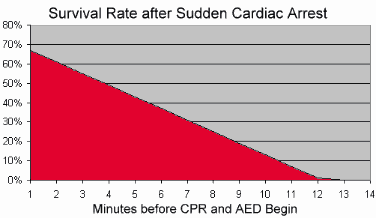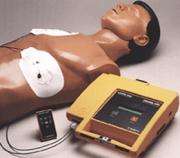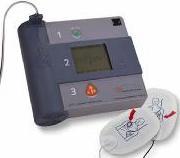
AED & CPR Skills

Automated External Defibrillators (AEDs)
are the latest, most important, advancement in sudden cardiac arrest response. They are amazing little gadgets that pretty much anyone can operate with little aed training and they are popping up all over the place, from schools to churches to health clubs to homes.
Ventricular Fibrillation (VF)
is an electrical abnormality where the heart stops pumping because the electrical impulses in the heart are out of synch, causing it to quiver instead of beat. I like the analogy of this being like an hysterical person who is screaming and crying and beyond reason - a rude slap in the face shocks them into gaining composure. If VF is treated quickly, the heart can get back to work just fine - if not treated, VF degrades to something called 'asystole' which is generally fatal.
Importance of Rapid Response

If a VF victim gets his heart pattern restored immediately following a sudden cardiac arrest, he has about a 2/3rds chance of recovery. Every minute that revival is delayed, the chances drop until there is little hope after 10 minutes.
CPR is not a means to revival. CPR is a temporary bandaid to keep oxygen flowing to the brain until a way to revive the victim is ready. Not many years ago, that means of revival was only available in hospitals, operated by highly trained medical personnel. Manual external defibrillators are used to apply an electric shock to victims in an attempt to restore a useful pattern to the heart muscle. Doing CPR in the field while a means to revival is bolted to the floor in a hospital does the victim no good.
The next step was to make the defibrillators portable. These portable defibrillators were installed in ambulances. With this advancement, CPR in the field made sense. If a person could keep blood flowing until the ambulance arrived, there was a chance of recovery. But, arrival times could be 15 minutes, 30 minutes, or longer.

AEDs Arrive
Around 1980, the AED (automated external defibrillator) debuted. The 'automated' part is what is really exciting. Now people with only minimal training can successfully revive VF victims in the field, even before Emergency Medical Services personnel arrive. An AED can be down the hall, just 1 or 2 minutes away, so chances for revival are way up. The AED can automatically analyze the victim and decide if a shock is required or not. The operator just needs to follow simple commands from the AED and push the shock button when/if told to push it.AEDs are nearly error-free, weigh under 5 lbs, are simple to learn and operate, are safe, can be stored anywhere, and they work! There are a few different types of AEDs and improvements are being made all the time. Many people have home defibrillators and there are personal aeds that are worn under clothing and automatically analyze and apply shock as needed.
Using an AED
As soon as a victim is encountered and it is determined that they are unresponsive, three things need to happen:- Someone calls 9-1-1 if a phone is available
- Someone retrieves the AED if one is available
- Someone checks for breathing and circulation and begins CPR if needed
If there are only 2 people, one calls 9-1-1 and gets the AED while the second begins CPR.
If you are all alone, you should do them all in the order listed even if it means leaving the victim - call 9-1-1, get the AED, and then check for breathing.
If the victim is not breathing, follow these steps to perform CPR with an AED:
- Position the victim on his back.
- Tilt head back and lift chin. Check for breathing for no more than 10 seconds.
- Turn on the AED and follow audio commands.
- Open the victim's shirt and wipe his chest dry of sweat or water.
- Attach one pad to the victim's upper right chest and one to the lower left side. The pads will be labelled with a picture of where they go.
- Plug the wire from the pads into the AED if they are not already attached.
- Make sure no one is touching the victim so the AED can analyze correctly.
- Push the 'Analyze' button or let the AED automatically begin its analysis. Just wait for the analysis to complete.
- If the AED determines a shock is required:
- Keep everyone clear of the victim.
- Press the 'shock' button.
- Let the AED reanalyze.
- If the AED determines no shock is needed:
- Check for signs of life.
- Perform CPR as needed until the AED reanalyzes.

AED Q & A
- Can I hurt someone by using an AED on them? No, the AED automatically analyzes and determines if a shock is required. If you have determined to use an AED, then the person is essentially dead already anyway. You should participate in some aed training before using an AED.
- Can I get sued for using an AED? Yes, you can get sued for any reason. Chances of you losing a suit because you used CPR and an AED attempting to revive someone are very close to zero. Finding 'Good Samaritans' at fault is very rare.

